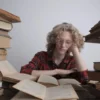Did you know that crayons care about identity politics and race? I didn’t. I just thought they were great for coloring!
Luckily I came across The Day the Crayons Quit, by Oliver Jeffers.
Each crayon writes a note to a little boy, Duncan, with a complaint. Either Duncan colors with them too much or too little, he doesn’t appreciate them sufficiently, or he calls them the wrong name. This line from the Beige Crayon pretty much sums it up: “I’m tired of being called ‘light brown’ or ‘dark tan’ because I am neither. I am BEIGE and I am proud.”
In the end, Duncan takes all of their advice and uses his crayons to draw a picture that depicts almost no objects in traditional colors. He receives an ‘A’ from his teacher for such a creative drawing.
Don’t get me wrong. I’m all for whimsically drawing pink dinosaurs and green water. But I can’t help but wonder if there was an ulterior motive at play in this story.
These outraged crayons seem to be training Duncan to be a people pleaser. Nothing and no one should be unequally favored. Don’t assume that someone ascribes to traditional cultural structures. Only children who break free from the constraints of reality are good.
In a culture of political correctness, I didn’t spend much time wondering why the author took this route.
But at least the crayon book recognizes that there is a reality, even if it finds it objectionable. Other books abandon reality and embrace existential questions instead. Such is the path taken by Mac Barnett and Jon Klassen in a new series of children’s books, TRIANGLE, SQUARE, and CIRCLE. Let’s take a look at CIRCLE:
In CIRCLE, Triangle, Circle, and Square are playing a friendly game of hide and seek. Circle is “it” and searches for her friends. Searching inside a cave so dark that only the whites of her eyes are visible, she finds Triangle… and another set eyes. The two shapes assume that Square has followed Circle in and that these are his eyes. But upon exiting the cave, Triangle and Circle find Square waiting outside for them. He denies that he entered the cave at all. Innocently, they wonder what shape they might have seen in the darkness. The book ends with the narrator breaking the fourth wall by asking the reader, “If you close your eyes, what shape do you picture?”
As the reader, I assumed that either Square was lying, or there was a stranger lurking in the cave near their play area. I was half-expecting some stranger-danger instruction to follow. But I was wrong.
Why does it end there? The plotline reached its climax, but where is the resolution?
This maze of bewilderment seems to be a new trend for children’s books. Instead of heroic stories that give children role models, we find half-finished books with a weird unease and decided lack of solutions.
As a child I loved Ludwig Bemelmens’ classic Madeline book. Madeline is a fun-loving little girl who wakes up sick in the middle of the night. She is taken to the hospital to have her appendix taken out. But the story doesn’t end with an existential question about whether the doctor was right that she had appendicitis. No interjection comes from the appendix saying how it feels about being discarded from little Madeline. Rather, the story continues with Madeline recovering, showing off her new scar on her tummy, and receiving flowers and toys from the other girls to cheer her up.
Madeline teaches courage and kindness, rather than existential crises. Why have we rejected classic children’s books for this chaotic mess?
I’m a bit confused.
—
Dear Readers,
Big Tech is suppressing our reach, refusing to let us advertise and squelching our ability to serve up a steady diet of truth and ideas. Help us fight back by becoming a member for just $5 a month and then join the discussion on Parler @CharlemagneInstitute and Gab @CharlemagneInstitute!
Image Credit:
Max Pixel
















Leave a Comment
Your email address will not be published. Required fields are marked with *